Articles
- Page Path
- HOME > J Korean Acad Nurs > Volume 43(2); 2013 > Article
-
Original Article
- Body Image Dissatisfaction as a Mediator of the Association between BMI, Self-esteem and Mental Health in Early Adolescents: A Multiple-group Path Analysis across Gender
- Mi Heui Jang, Gyungjoo Lee
-
Journal of Korean Academy of Nursing 2013;43(2):165-175.
DOI: https://doi.org/10.4040/jkan.2013.43.2.165
Published online: April 30, 2013
1College of Nursing Science and East-West Nursing Research Institute, Kyung Hee University, Seoul, Korea.
2College of Nursing, University of Illinois at Chicago, Chicago, Illinois, USA.
- Address reprint requests to: Jang, Mi Heui. College of Nursing Science and East-West Nursing Research Institute, Kyung Hee University, #1, Hoegi-dong, Dongdaemun-gu, Seoul 130-701, Korea. Tel: +82-2-961-0592, Fax: +82-2-961-9398, mhjang@khu.ac.kr
© 2013 Korean Society of Nursing Science
Abstract
-
Purpose
- This study was done to examine not only the relationships between body mass index (BMI), self-esteem, body image dissatisfaction (BID) and mental health, according to gender, but the mediating role of BID on mental health in relation to BMI and self-esteem among early adolescents.
-
Methods
- Data from 576 (296 boys and 280 girls) elementary school students in grades 5 to 6 were collected. A multiple-group path analysis was utilized to examine the relationships between BMI, self-esteem, BID and mental health by gender.
-
Results
- In the path analysis for all students, poor mental health was related directly to BID, while it was indirectly related to BMI and self-esteem. In the multiple-group path analysis of both genders, BID was found to have a significant direct and indirect effect on mental health for girls alone.
-
Conclusion
- The findings suggested that BID should be examined early to prevent poor mental health in early adolescent girls. This study helps to elucidate the role of early adolescent BID on mental health and provides insight for further prevention and intervention programs in school and community mental health settings.
- 1. Brausch AM, Muehlenkamp JJ. Body image and suicidal ideation in adolescents. Body Image. 2007;4(2):207–212. http://dx.doi.org/10.1016/j.bodyim.2007.02.001.ArticlePubMed
- 2. Byrne BM. Structural equation modeling with AMOS: Basic concepts, applications, and programming. 2010;2nd ed. New York, NY, Taylor & Francis Group.
- 3. Chan F, Lee GK, Lee EJ, Kubota C, Allen CA. Structural equation modeling in rehabilitation counseling research. Rehabil Couns Bull. 2007;51(1):44–57.ArticlePDF
- 4. Chyung YJ. Relationships between body image attitude and its correlates in early adolescence. J Korean Home Econ Assoc. 2010;48(5):103–117.Article
- 5. Derogatis LR, Rickels K, Rock AF. The SCL-90 and the MMPI: A step in the validation of a new self-report scale. Br J Psychiatry. 1976;128:280–289.ArticlePubMed
- 6. Fairburn CG, Cooper Z, Cooper PJ. Brownell KD, Foreyt JP. The clinical features and maintenance of bulimia nervosa. In: Handbook of eating disorders: Physiology, psychology, and treatment of obesity, anorexia, and bulimia. 1986;New York, NY, Basic Books. 389–404.
- 7. Gilliland MJ, Windle M, Grunbaum JA, Yancey A, Hoelscher D, Tortolero SR, et al. Body image and children's mental health related behaviors: Results from the healthy passages study. J Pediatr Psychol. 2007;32(1):30–41. http://dx.doi.org/10.1093/jpepsy/jsl008.ArticlePubMed
- 8. Han SS. Relationships between elementary school student's appearance recognition and satisfaction on self-concept and mental health. 2006;Gangwon, Chuncheon National University of Education. Unpublished master's thesis.
- 9. Harter S. Manual for the self-perception profile for children. 1985;Denver, COL, University of Denver.
- 10. Huang L, Tao FB, Wan YH, Xing C, Hao J, Su PY, et al. Self-reported weight status rather than BMI may be closely related to psychopathological symptoms among Mainland Chinese adolescents. J Trop Pediatr. 2011;57(4):307–311. http://dx.doi.org/10.1093/tropej/fmp097.ArticlePubMed
- 11. Hyun MS, Kim KH, Kim SA. Influencing factors on problem behaviors among adolescents: Focused on middle school students in Seoul. J Korean Acad Nurs. 2004;34(2):252–260.ArticlePDF
- 12. Hyun MS, Nam KA, Kong SS. A study of relationship between adolescents' sexual development and problem behavior and depression-focused on middle school students in Kyungki-Do. J Korean Acad Psychiatr Ment Health Nurs. 2001;10(4):533–547.ArticlePDF
- 13. Kim DS. Body image dissatisfaction as an important contributor to suicidal ideation in Korean adolescents: Gender difference and mediation of parent and peer relationships. J Psychosom Res. 2009;66(4):297–303. http://dx.doi.org/10.1016/j.jpsychores.2008.08.005.ArticlePubMed
- 14. Kim DS, Kim HS. Body-image dissatisfaction as a predictor of suicidal ideation among Korean boys and girls in different stages of adolescence: A two-year longitudinal study. J Adolesc Health. 2009;45(1):47–54. http://dx.doi.org/10.1016/j.jadohealth.2008.11.017.ArticlePubMed
- 15. Kim JM, Yi SJ. Developmental changes in the effect of sociocultural factors towards appearance, body mass index and self-esteem on body image. J Korean Home Manage Assoc. 2009;27(6):1–12.
- 16. Kim KI, Kim JH, Won HT. Korean manual of symptom check list-90-revision. 1984;Seoul, ChungAngJukSung Publisher.
- 17. Kim MY. Comparison of body image, self-esteem and behavior problems between children of short and normal stature. J Korean Acad Child Health Nurs. 2010;16(1):41–48. http://dx.doi.org/10.4094/jkachn.2010.16.1.41.Article
- 18. Kong SS. Impact of eating psychopathology, obsessive-compulsion and depression on self-harm behavior in patients with eating disorders. J Korean Acad Nurs. 2009;39(4):459–468. http://dx.doi.org/10.4040/jkan.2009.39.4.459.ArticlePubMed
- 19. Kostanski M, Fisher A, Gullone E. Current conceptualisation of body image dissatisfaction: Have we got it wrong? J Child Psychol Psychiatry. 2004;45(7):1317–1325. http://dx.doi.org/10.1111/j.1469-7610.2004.00315.x.Article
- 20. Lee HJ. REBT group counseling program development for elementary school obese girls' body image-peer relationship improvement. 2009;Chung-buk, Korea National University of Education. Unpublished master's thesis.
- 21. Lee HY. The correlation between their body image and self-esteem dependent on the degree of obesity of obese children. 2004;KongJu, KongJu National University. Unpublished master's thesis.
- 22. Mendelson BK, White DR. Self-esteem and body esteem: Effects of gender, age, and weight. J Appl Dev Psychol. 1996;17(3):321–346. http://dx.doi.org/10.1016/S0193-3973(96)90030-1.Article
- 23. Ohring R, Graber JA, Brooks-Gunn J. Girls' recurrent and concurrent body dissatisfaction: Correlates and consequences over 8 years. Int J Eat Disord. 2002;31(4):404–415. http://dx.doi.org/10.1002/eat.10049.ArticlePubMed
- 24. Park HS. Validation of a path model on adolescents' suicidal ideation and violent behavior. J Korean Acad Nurs. 2007;37(6):835–843.ArticlePDF
- 25. Ricciardelli LA, McCabe MP, Holt KE, Finemore J. A biopsychosocial model for understanding body image and body change strategies among children. J Appl Dev Psychol. 2003;24(4):475–495. http://dx.doi.org/10.1016/S0193-3973(03)00070-4.Article
- 26. Riesch SK, Anderson LS, Krueger HA. Parent-child communication processes: Preventing children's health-risk behavior. J Spec Pediatr Nurs. 2006;11(1):41–56. http://dx.doi.org/10.1111/j.1744-6155.2006.00042.x.ArticlePubMed
- 27. Shin NY, Shin MS. Body dissatisfaction, self-esteem, and depressionin obese Korean children. J Pediatr. 2008;152(4):502–506. http://dx.doi.org/10.1016/j.jpeds.2007.09.020.ArticlePubMed
- 28. Smolak L. Body image in children and adolescents: Where do we go from here? Body Image. 2004;1(1):15–28. http://dx.doi.org/10.1016/s1740-1445(03)00008-1.ArticlePubMed
- 29. Stice E. Risk and maintenance factors for eating pathology: A meta-analytic review. Psychol Bull. 2002;128(5):825–848.ArticlePubMed
- 30. ter Bogt TF, van Dorsselaer SA, Monshouwer K, Verdurmen JE, Engels RC, Vollebergh WA. Body mass index and body weight perception as risk factors for internalizing and externalizing problem behavior among adolescents. J Adolesc Health. 2006;39(1):27–34. http://dx.doi.org/10.1016/j.jadohealth.2005.09.007.ArticlePubMed
REFERENCES
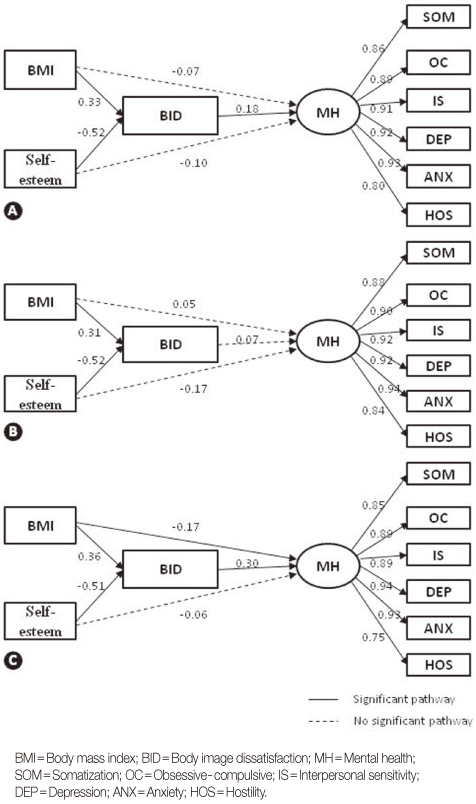
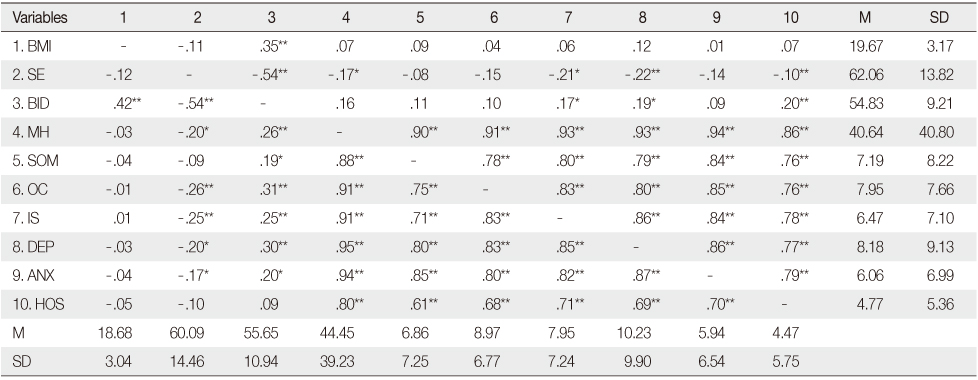
Correlations above the diagonal are for boys (n=296); Those below the diagonal are for girls (n=280); Means and standard deviations in the vertical columns are for boys those in the horizontal rows are for girls; BMI=Body mass index; SE=Self-esteem; BID=Body image dissatisfaction; MH=Mental health; SOM=Somatization; OC=Obsessive-compulsive; IS=Interpersonal sensitivity; DEP=Depression; ANX=Anxiety; HOS=Hostility; *p<.05; **p<.01.
Figure & Data
REFERENCES
Citations

- The Effects of Programs on Body-Image Improvement in Adolescents: A Systematic Review and Meta-Analysis
Hyun Jung Yun, Kyoungsan Seo, Dallong Han
Journal of Korean Academy of Nursing.2021; 51(5): 597. CrossRef - Biochemical Index, Nutrition Label Use, and Weight Control Behavior in Female Adolescents: Using the 2010 and 2011 Korea National Health and Nutrition Examination Survey
Mi-Ja Choi, Hyun-Ju Jo, Mi-Kyung Kim
Clinical Nutrition Research.2020; 9(1): 32. CrossRef - Public mental health under the long-term influence of COVID-19 in China: Geographical and temporal distribution
Yali Ren, Wei Qian, Zezhi Li, Zhengkui Liu, Yongjie Zhou, Ruoxi Wang, Ling Qi, Jiezhi Yang, Xiuli Song, Lingyun Zeng, Xiangyang Zhang
Journal of Affective Disorders.2020; 277: 893. CrossRef - A path analysis of factors influencing eating problem among young female adults
Bo-Kyoung Cha
Journal of Nutrition and Health.2017; 50(6): 615. CrossRef - Survey on Foodservice Satisfaction and Dietary Education needs for Improvement of School Foodservice in Middle School Students in Seoul
Kyung-Hee Shin, Youngmee Lee, Wookyoun Cho
Korean Journal of Community Nutrition.2017; 22(2): 127. CrossRef - Effects of the difference between actual body condition and body image perception on nutrient intake, weight control and mental health in Korean adults: Based on the 5th Korea National Health and Nutrition Examination Survey
Jihyun Seo, Hyesun Ma, Sunghee Kim, Jiyoung Kim, Minseo Shin, Yoon Jung Yang
Journal of Nutrition and Health.2016; 49(3): 153. CrossRef - Parent Involvement Intervention in Developing Weight Management Skills for both Parents and Overweight/Obese Children
Hee Soon Kim, Jiyoung Park, Kye-yeong Park, Myung-Nam Lee, Ok Kyung Ham
Asian Nursing Research.2016; 10(1): 11. CrossRef - Structural Equation Modeling Intention of Revision Facial Cosmetic Surgery in Female College Students
Bock Soon Park, Joo Hyun Kim
Journal of the Korea Academia-Industrial cooperation Society.2015; 16(12): 8707. CrossRef - Associations of physical activity by intensity (moderate vs. vigorous) with depression and suicidal thoughts among middle school students in South Korea
Ji-Yeon An
Journal of the Korea Academia-Industrial cooperation Society.2014; 15(12): 7266. CrossRef - Women’s Experiences of Sexual Attention: a Cross-Sectional Study of U.S. University Students
Samantha J. Gregus, Christina M. Rummell, Thomas J. Rankin, Ronald F. Levant
International Journal of Sexual Health.2014; 26(4): 239. CrossRef
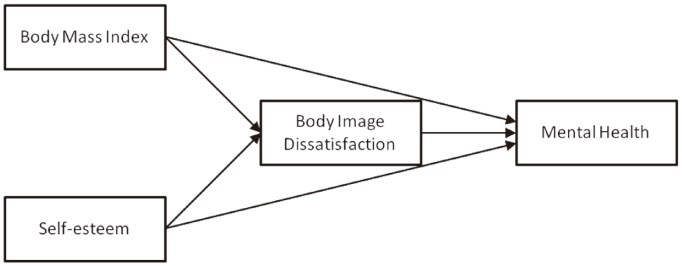

Figure 1
Figure 2
Correlations, Means and Standard Deviations for Measured Variables in the Two Groups
Correlations above the diagonal are for boys (n=296); Those below the diagonal are for girls (n=280); Means and standard deviations in the vertical columns are for boys those in the horizontal rows are for girls; BMI=Body mass index; SE=Self-esteem; BID=Body image dissatisfaction; MH=Mental health; SOM=Somatization; OC=Obsessive-compulsive; IS=Interpersonal sensitivity; DEP=Depression; ANX=Anxiety; HOS=Hostility; *p<.05; **p<.01.
Goodness-of-fit Statistics for the Path Models of All Students and Multiple-groups (boys and girls)
Maximum-likelihood Estimates of Standardized Path Coefficients Mediating Effect of Body Image Dissatisfaction in Path Model for All Students and Multiple-group Path Model by Gender
SMC=Squared multiple correlations; BMI=Body mass index.
Correlations above the diagonal are for boys (n=296); Those below the diagonal are for girls (n=280); Means and standard deviations in the vertical columns are for boys those in the horizontal rows are for girls; BMI=Body mass index; SE=Self-esteem; BID=Body image dissatisfaction; MH=Mental health; SOM=Somatization; OC=Obsessive-compulsive; IS=Interpersonal sensitivity; DEP=Depression; ANX=Anxiety; HOS=Hostility; *
SMC=Squared multiple correlations; BMI=Body mass index.
 KSNS
KSNS
 E-SUBMISSION
E-SUBMISSION

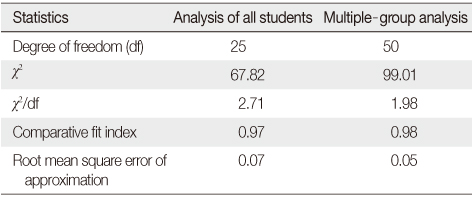
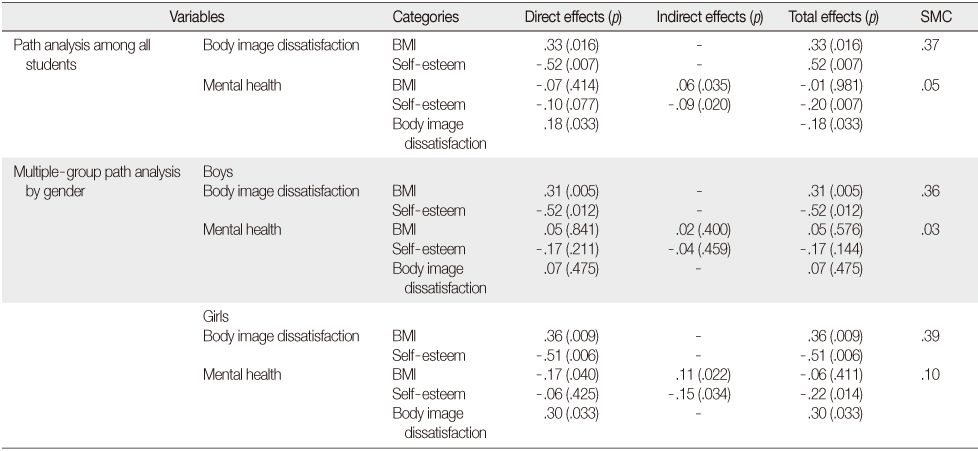
 Cite
Cite

